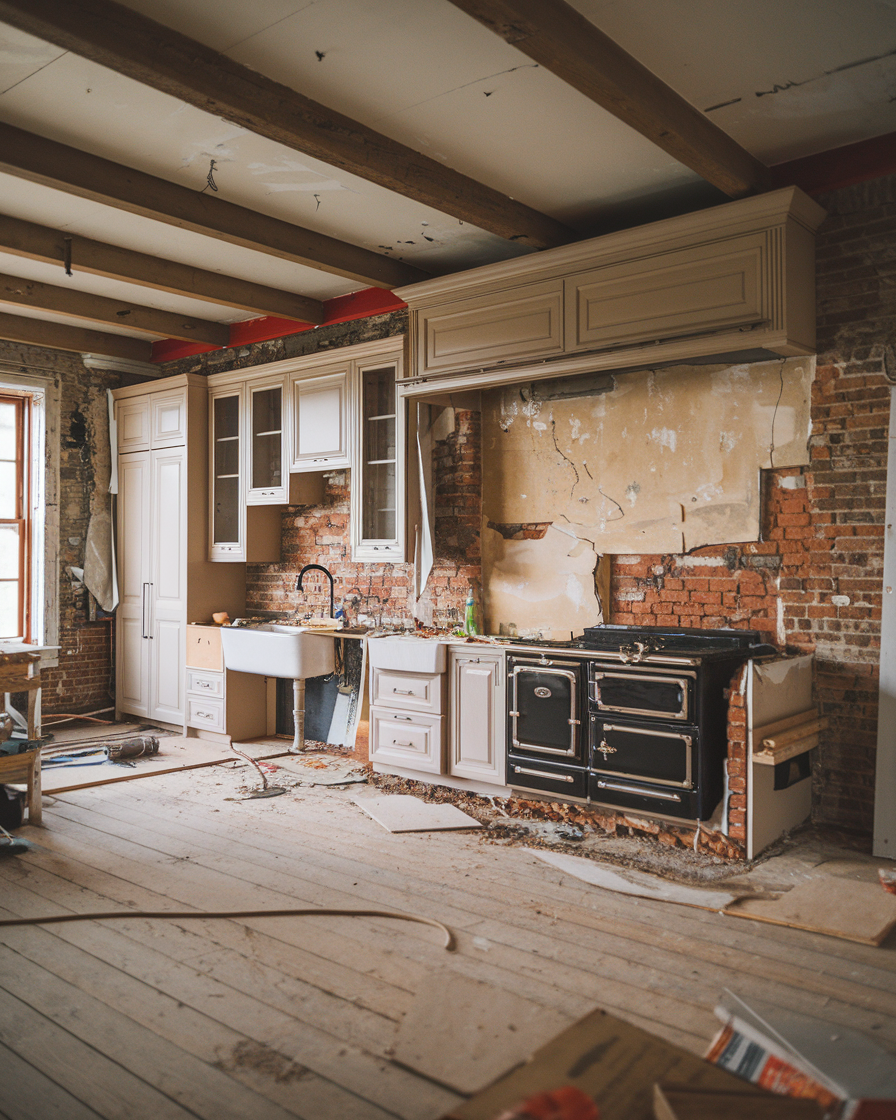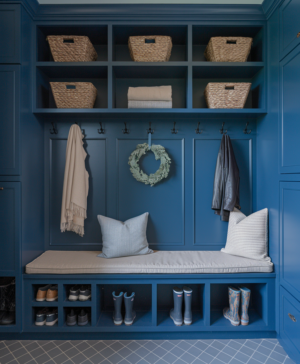
It’s a commonly touted statistic that 50% of couples report experiencing significant stress on their marriage due to home renovations. But fear not! We’re here to not only save your relationship, but to also help you navigate the chaos of a remodel. We’ll touch on everything from finding the right professionals to pinpointing key areas for maximum return on your investment (ROI). And trust me, it’s not as dull as it sounds! Keep reading to learn how to balance creativity and function with cost-effectiveness during a renovation or remodel.
Renovation vs Remodel
When people use terms like “remodel” and “renovation,” they often mix them up like they’re the same thing. Technically speaking, there is a bit of a difference. But in reality, it’s socially acceptable to use the terms interchangeably. The easiest way to explain it is that renovations are typically less expensive and less extensive in scope.
Those dream countertops and backsplash you’ve been salivating over on your Pinterest board? Yeah, that’s a renovation! They’re usually the quicker or more budget-friendly fixes like giving your space a refresh with new flooring, paint, fixtures, etc.
On the other hand, maybe you’re actually obsessing over a complete gut job so you can craft your ideal mid century modern kitchen made for hosting. Or perhaps you want to reconfigure your bedrooms to include the dream walk-in closet of every fashion influencer (that you’ll probably never be able to fill up). Either way, a remodel is about transforming a space into some that’s basically new, often involving major structural or layout changes. Keep in mind, these projects usually need some professional help and will often involve permits and local regulations (yes, they are eternally annoying to keep up with).
Figuring out if you’re dealing with a renovation or a remodel is something to take into consideration when you’re planning any work to your home, but it’s not the most important part by any means. However, knowing what each involves will help you set more realistic goals and budgets (because we all know that’s the hardest part) —whether you’re just sprucing up the look or gearing up for some serious changes.
Remodeling Red Flags
Ignoring warning signs could lead to bigger headaches down the road, putting both your safety and your home’s structure at risk. If your house is starting to show its age with outdated features or designs that make daily life a hassle (like that broken microwave handle you keep forgetting to fix), then it’s probably time for a home remodel. Plus, if your utility bills are mysteriously climbing, it might be because of your home’s inefficiencies—something a modern renovation could fix by boosting energy efficiency and cutting costs in the long run. Spotting these signs early not only bumps up your property value but also makes your living space way more functional and enjoyable.

Warning Signs
It’s always important to pay attention to your living space and appliances. You can’t plan for updates without first recognizing what’s starting to fail. So, what are the signs that your home is screaming for a remodel? They may include:
- Leaky windows or roof
- Damaged, loose, or cracked flooring
- Faded or peeling paint
- Moldy, chipped bathroom tiles
- Deep or horizontal wall cracks that can point to foundation issues
- Outdated (i.e. dangerous) electrical systems
- Insufficient insulation
The Planning Phase
You may not want to hear it, but the secret to a successful home remodel is all in the planning, my friend. Start by setting your priorities straight and creating a budget that won’t send you spiraling into a financial abyss. Trust me, you’ll want to keep a tight grip on the reins of any project budget. Bringing in the pros who vibe with your style and wallet will make the whole remodeling adventure much less stressful.
The breakdown:

Clear Priorities & Budget
First things first, get that budget in check. Depending on how grand your plans are, you might be looking at anything from $5,000 to a whopping $300,000+. Yeah, I know, that’s quite the range! Nailing down an accurate budget is your ticket to keeping your expenses in line and maybe even seeing some sweet return on investment (ROI). Oh, and don’t forget to toss in a 20% cushion for those little surprises that will inevitably pop up.
Once you’ve got your budget sorted, make a list of what you want to achieve with this remodel. Focus on the key areas first, so you can spend your cash wisely and get the results you’re dreaming of. When you’re ready to get quotes, having detailed specs will help you get much more accurate estimates from contractors.
Choosing the Right Professionals
Picking the right crew for your remodel can make or break the entire thing. We’ve all heard horror stories like these about contractors ripping off customers! You want to get the trustworthy and seasoned pros early because, let’s be real, the good ones are always booked solid (for reference, at my last job with a small remodeling company, we’d book out 12-24 months in advance). It’s also why planning in advance is so important. Check out their licenses, insurance, and references. Now is the time to use those online sleuthing skills you developed from spying on your ex to dig up reviews, complaints, recommendations, and portfolios on your contractor. You may also want to check Reddit forums mentioning the company (but please use discernment when reading these and look for proof to back up any negative claims).
Get recommendations for at least two or three contractors, if possible, to keep things competitive. Check out their recent work and see what past clients have to say.
Best Bang for Your Buck: Key Areas for Maximum ROI
When it comes to home renovations, some areas pack a bigger punch than others. Kitchens and bathrooms, for instance, are the rockstars of the remodeling world, often delivering impressive ROI. If a major concern for you is maintaining or increasing the resale value of your home, then tailor your plans to what both you and potential buyers are into, and you’ll be golden.
Let’s explore these high-impact zones.
Kitchen Remodeling

Despite what MTV Cribs would have you believe, the kitchen is actually where the magic happens, and it’s a major player when it comes to adding value to your place. Even small updates, like swapping out an old backsplash or finding some leftover materials for new countertops, can make a big difference (don’t sleep on butcher block counters!).
Don’t forget about functionality! A fresh coat of paint or new hardware on those cabinet doors can give your storage areas a whole new look. And hey, why not let technology lend a hand? Apps and tech like Remodel AI can help you visualize your dream kitchen before you even pick up a hammer. It’s like having a crystal ball for your remodel, and having your finishes chosen up front will get you a much more accurate bid with less overages and surprises.
Bathroom Remodeling

Ah, the bathroom—a small space with a massive impact. A bathroom remodel can seriously up your home’s game, making it more comfy and appealing to buyers. Simple changes like a new vanity, updated hardware, or refinishing an existing tub or shower can add a modern touch without breaking the bank.
These upgrades can boost your property’s value, making them a smart investment. Find dupes for high end finishes and fixtures (build.com is my absolute go-to vendor for projects!). Focus on high-impact changes that won’t drain your wallet (e.g. a new stock vanity, new shower head, new lighting, fresh paint) but will enhance both the practicality and style of your bathroom.
Areas with (Surprisingly) Low Impact

First impressions do matter, and you want to have good curb appeal. However, spending a large chunk of your budget on exterior changes other than simple repairs or refreshing won’t give you a very good return on your investment from an appraiser’s perspective. And since plants can die at any time, they don’t technically add value, but curb appeal is always helpful for open houses and showings and may make your property sell faster, if not for more money.
Upgrading outdoor living areas like decks and patio are similar to landscaping, but they do add more value on average. But if you plan on using the space then it may still be worth the cost. It not only makes your home look good but also adds functional space and is considered an amenity (which is not valued at the same price/sq ft as living area). Investing in these projects can potentially pay off if you specifically add an amenity that is exceedingly popular or desirable in your region (think having a pool in Florida).
DIY vs. Hiring Professionals
Deciding whether to go the DIY route or call in the pros is an important part of your renovation journey. DIY gives you the freedom to work on your own schedule, but without the right skills, it can lead to costly mistakes. Plus, DIY projects tend to take way longer than expected. Despite these concerns, I do believe anyone can figure it out with good YouTube tutorials if they commit to it!
But if you aren’t very skilled or handy then hiring professionals will usually mean better quality work because they (should) stick to safety standards and building codes. It might cost more upfront, but having skilled folks on board often makes the process quicker and smoother overall.
Leveraging Technology in Home Remodeling
In today’s tech-savvy world, using technology can totally level up your home remodeling game. Take Remodel AI, for example. It lets you see what changes could look like in your home before you even lift a finger.
Using tech like this boosts efficiency and helps you make more informed decisions about your remodel. Plus, it’s fun to play around with for inspiration.
Using Remodel AI for Design Ideas
Remodel AI is a game-changer, helping you visualize projects in all sorts of styles. The app lets you play around with your home’s interior or exterior, showing you a fully remodeled version. The Reskin feature even lets you recolor existing objects like furniture and walls.
Sure, the app has its quirks, like idle saving and no troubleshooting guide, but interior designers love its design idea renderings for their effectiveness.

Online Resources for Learning Upgrades
The internet is chock-full of resources to guide you through DIY upgrades and home renovations. Websites and video platforms like YouTube offer comprehensive tutorials, making home improvement a breeze for those eager to learn. These online materials can empower homeowners with the skills and confidence needed to tackle remodeling projects.
Remodel AI acts as a digital assistant, enhancing decision-making in renovation by visualizing potential outcomes before any changes are made. By using these virtual aids, you can cut costs while ensuring your remodeling plans align with your vision.
Trends vs Functionality in Home Remodeling
Current home remodeling trends are all about blending aesthetics with efficiency. Popular features include:
- Double kitchen islands (personally, I’m not a fan but you do you!)
- Smart technology that boosts usability (because who wants to get up to turn off the lights?)
- Adding natural light
- Warm wood tones + mixing textures
- Colorful cabinets, paint, or wallpaper
Nooks and flex rooms also add style and functionality, making your home more versatile and appealing, especially with the increase in work-from-home jobs and alternative family structures. While trends are cool, never forget that functionality should always come first. Aesthetics won’t matter when you’re trying to prepare a huge Thanksgiving feast in your cramped kitchen layout!
Budget-Friendly Remodeling Options
Renovating on a budget doesn’t mean skimping on quality. Choosing cost-effective materials and adding simple decorative touches can change your home’s look without breaking the bank. Quick updates like peel-and-stick floor tiles or new window coverings can refresh a room easily.
Building a contingency fund into your budget covers any unexpected costs that might (will) pop up. Focusing on budget-friendly choices lets you create an attractive renovation while staying financially responsible and avoiding overspending.

Emotional Attachment and Lifestyle Considerations
Embarking on a home remodeling journey can be an emotional rollercoaster, filled with the excitement of a transformation and the stress of endless design decisions. That relief and peace and comfort you feel after it’s done is totally worth it.
It’s crucial to tailor your renovation to your lifestyle needs, including features for accessibility that support aging in place. Whether your priorities are cozy dinner parties or a kid-friendly home, designing a space that adapts to both present and future requirements ensures you can avoid another remodel.
Maximizing Return on Investment
Focusing on specific areas during your home remodel can significantly boost your potential return on investment (ROI). High returns often come from updating kitchens and bathrooms. For example, investing in a bathroom remodel not only recovers costs when you sell but also increases your property’s overall value.
Be budget-conscious about exterior renovations that won’t get you as much bang for your buck in the long run.

Summary
To wrap it all up, pulling off a successful home remodel requires careful planning, setting realistic budgets, and choosing the right experts. Focusing on key areas like kitchens and bathrooms can seriously boost your property’s value. Using technology and digital tools can simplify the remodeling journey and enhance the process along the way. Despite the potential bumps in the road, the satisfaction of transforming your home is totally worth it.
Ready to start your renovation? Follow us for more tips, tricks, and advice for all your real estate and design questions.



